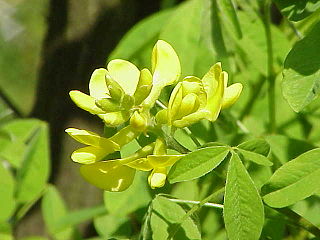
Petteria ramentacea, commonly known as Dalmatian laburnum, is a species of flowering plant in the family Fabaceae. It is a deciduous shrub native to the western Balkan Peninsula, including Greece, Albania, Bosnia and Herzegovina, and Montenegro. It grows up to 3 meters tall, and flowers in May. It grow in shrubland and scrub from 10 to 700 meters elevation, in both sub-Mediterranean and Mediterranean habitats. It belongs to the subfamily Faboideae. It is the only member of the genus Petteria.

Argyrocytisus battandieri, the pineapple broom or Moroccan broom is a species of flowering plant in the legume family, Fabaceae, subfamily Faboideae. It is the only member of the genus Argyrocytisus.
Podocytisus caramanicus is a species of flowering plant in the family Fabaceae. It is a shrub native to the western Balkan Peninsula and southern Turkey. It is the only member of the genus Podocytisus. It belongs to the subfamily Faboideae.

Cyamopsis is a genus of the family Fabaceae. Its species are distributed across sub-Saharan Africa, Saudi Arabia, Pakistan, and India. Typical habitats include tropical seasonally-dry thorn scrub and grassland, often in floodplains, stream beds, and pans, and in open sandy or rocky areas.

Xanthocercis is a tree genus in the family Fabaceae. It includes three species native to sub-Saharan Africa.
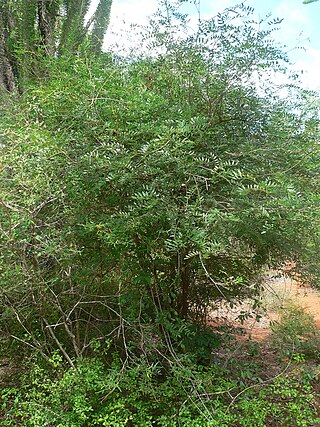
Cordyla is a genus of flowering plants in the family Fabaceae. It includes seven species native to sub-Saharan Africa, ranging across northern Africa from Senegal to Somalia, and through eastern Africa from Sudan to KwaZulu-Natal, including Madagascar.

Adenocarpus is a genus of flowering plants in the family Fabaceae. It belongs to the subfamily Faboideae. The plants are broom-like shrubs with bright yellow flowers. The genus is native to the Mediterranean Basin and sub-Saharan Africa, but finds its highest diversity in Northwest Africa and the Iberian Peninsula.
Bobgunnia is a genus of flowering plants in the legume family, Fabaceae. It belongs to the subfamily Faboideae. It includes two species native to sub-Saharan Africa. The genus is named for Charles R. Gunn who was the director of the U.S. National Seed Herbarium for many years before his retirement.

Bolusanthus speciosus is a species of flowering plants in the family Fabaceae. It belongs to the subfamily Faboideae. It is the only member of the genus Bolusanthus.
Errazurizia (dunebroom) is a genus of flowering plants in the family Fabaceae. It belongs to subfamily Faboideae. It includes four species of subshrubs native to the western Americas.

Holocalyx balansae is a species of flowering plant in the legume family, Fabaceae. It belongs to the subfamily Faboideae. It is the only member of the genus Holocalyx. It is a tree native to South America, where it ranges from eastern, southern, and west-central Brazil to Bolivia, Paraguay, and northeastern Argentina.
Mildbraediodendron excelsum is a species of flowering plant in the family Fabaceae, and the only species in the genus Mildbraediodendron. It is a tree native to sub-Saharan Africa, ranging from Ghana to South Sudan, Uganda, and Democratic Republic of the Congo. It grows in Guineo-Congolian forest and Victoria Basin forest–savanna mosaic. It belongs to the subfamily Faboideae.
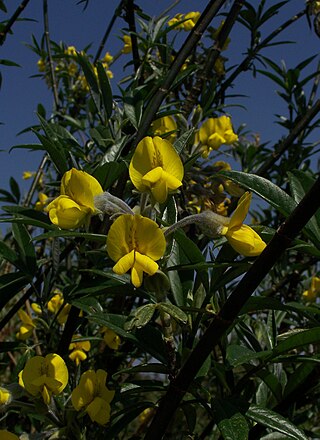
Piptanthus is a genus of flowering plants in the legume family, Fabaceae. It includes two species of shrubs native to the Himalayas, Tibet, Myanmar, and western China. They grow in montane grassland, thicket, and forest margins.
Platycelyphium voense is a species of flowering plant in the family Fabaceae. It is a tree native to Somalia, Ethiopia, Kenya, and Tanzania in eastern Africa. It grows in bushland and thicket in the Somali-Masai region. It is the only member of the genus Platycelyphium. It belongs to subfamily Faboideae.

Salweenia is a genus of flowering plants in the family Fabaceae. It includes two species of evergreen shrubs native to Tibet and Sichuan. It belongs to the subfamily Faboideae. They grow in dry continental temperate montane habitats, typically thickets on dry stony slopes, on gravel terraces, and in sandy stream beds.

Smithia is a genus of flowering plants in the legume family, Fabaceae. It includes 20 species of herbs or subshrubs native to sub-Saharan Africa, the Indian subcontinent, Indochina, southern China, Japan, Malesia, and northern Australia. The greatest diversity of species is in the Indian subcontinent, with 11 endemic species. Six more are widespread in southern and eastern Asia, and two of these, S. conferta and S. sensitiva, range further to northern Australia. Two species are endemic to sub-Saharan Africa. S. elliotii is native to Madagascar as well as mainland Africa, and S. conferta is also native to Madagascar. Typical habitats include seasonally-dry tropical grassland, wetlands, and streamsides.

Stauracanthus is a genus of flowering plants in the family Fabaceae. It includes three species of shrubs and suffrutices native to the Iberian Peninsula and northwestern Africa. They grow in Mediterranean-climate maquis (shrubland), woodland, heaths, and coastal scrub, on sandy or stony alluvium and coastal dunes. It belongs to subfamily Faboideae. It is sometimes treated as part of the genera Genista or Ulex.
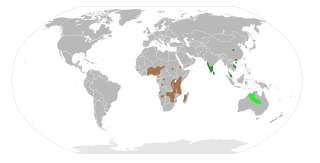
Rothia is a genus of flowering plants in the family Fabaceae. It belongs to the tribe Crotalarieae of subfamily Faboideae, and comprises two species:
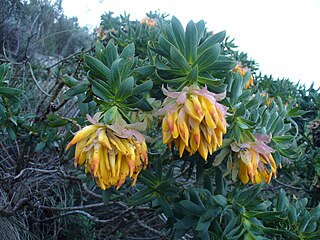
Liparia is a genus of flowering plants in the legume family, Fabaceae. It includes 20 species native to the Cape Provinces of South Africa. It belongs to the subfamily Faboideae.
Bowringia is a genus of flowering plants in the legume family (Fabaceae), found in tropical Africa and southeastern Asia. It includes four species native to western and central Africa and Madagascar, and to Borneo, Indochina, and southern China.














